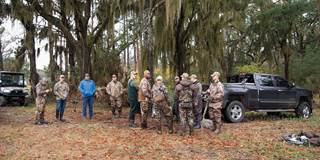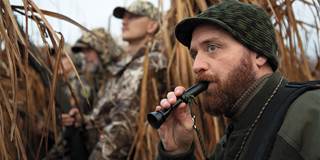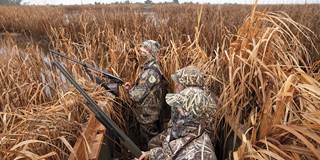Hunting with Heroes
A unique hunt in South Carolina's Lowcountry honors those who defend our freedoms
A unique hunt in South Carolina's Lowcountry honors those who defend our freedoms

By Eric Keszler
Steve Parry was finally relaxing. After a hectic morning organizing a waterfowling experience for 18 marines at various locations around the South Carolina Lowcountry, Parry had a few minutes to sit down and grab some breakfast. Taking a deep breath, he began to reflect on the purpose and meaning of the day's events. "What they do over there allows us to do what we do here," he said.
A US Marine Corps veteran of 26 years and now retired, Parry is the chairman of the Beaufort, South Carolina, DU chapter. Like other chapters, the Beaufort committee holds events throughout the year to raise money for DU's conservation work. In addition, they organize waterfowl hunts for military service members from local bases, including the Marine Corps Recruit Depot at Parris Island and the Marine Corps Air Station in Beaufort. Over the past eight years, 120 marines have been through a hunting experience like this one.

Photo Bill Buckley
Parry and other volunteers had spent this cold, wet Saturday morning seeing to all the details that an event like this entailsdoling out jackets and waders and shotguns and coffee, pairing up marines with volunteer guides, answering questions, and shuttling hunters to and from their blinds via pickup, boat, ATV, and boot soles. Now the hunters had returned from the marshes and availed themselves of a well-deserved Lowcountry breakfast. The young men gathered outside, admiring each other's birds and sharing stories of the morning's adventures, lingering as long as they could before loading up and returning to base.
Parry looked over the scene proudly. "For me to see their smilesit's worth every bit of work we put into it," he said. "These guys are my brothers. They're my family. I'll do anything for them."
Photographer Bill Buckley and I traveled to South Carolina's Lowcountry to take part in this special event and to meet the participants and the many volunteers and landowners who made it possible. Arriving the day before the hunt, we found ourselves in the heart of what locals call the ACE Basin, named for the Ashepoo, Combahee, and Edisto Rivers, which converge near Beaufort and send their waters into Saint Helena Sound and then the Atlantic Ocean. The region drained by these rivers is a rich and complex mix of upland forests, fresh and brackish marshes, and seasonally flooded stands of bottomland hardwoods. It is an area well known for diverse and valuable wildlife habitats in a relatively large and undeveloped landscape.
Any visit to the Lowcountry is a singular experience. The unique combination of landscape, culture, wildlife, and history make it unlike any other place I've visited. Spanish moss drapes from ancient oaks, historic homes offer glimpses into the region's rich history, and water seems to be everywhere on the landscapein rivers and creeks, coastal bays and marshes, flooded forests, and converted rice fields. These lush habitats support abundant wildlife, including many waterfowl species that winter here or stop to rest during spring and fall migrations.

Photo Bill Buckley
We met up with DU Conservation Specialist Ali Spulgis for a quick tour of Lowcountry highlights and a look at a few ongoing habitat projects involving DU and its many partners. Conservation activity across the region is intense. National wildlife refuges, state wildlife areas, and private lands represent combined efforts to restore habitats that have been lost and protect those that remain. Conservation easements play an important role in this work. The region is home to large estates that provide upland and wetland habitats for diverse wildlife species. Easements protect these properties from future development, ensuring their value to wildlife in perpetuity. It's difficult to think of a better place to provide an unforgettable waterfowling experience for young men serving our country.
Later that evening, we gathered for dinner with the marines and the event's organizers. The hunters had a chance to meet their guides and discuss plans and logistics for the following morning. Each participant received a blind bag, boxes of Winchester ammo, the obligatory DU hat, a duck call, and other swag.
Fresh-faced and energetic, the youngest of these marines were just out of high school. Others were veterans of multiple combat deployments. As I mingled and met as many of them as I could, I was impressed by the politeness and respect each of them demonstrated. All were excited about the opportunities that the following morning offered. To a man, they expressed their gratitude for the chance to take part in this waterfowling adventure.

Photo Bill Buckley
Patrick Earnest, a young Marine Corps captain stationed at Parris Island, was looking forward to his trip to a Lowcountry duck blind. But to him and to the other marines, the experience meant much more. "It's a humbling experience, knowing that people still care about the military," Earnest said. "You often have people say thanks for your service,' but here we see it in action. It helps put everything in perspective for us. We'll go back to work rested and ready and we'll share the word about conservation."
At four o'clock the next morning the rain was lashing the window of my room at Nemours Plantation, which served as headquarters for the hunt. The storm had been relentless throughout the night. With just one precious morning to spend with our guests, it looked like a washout. Would these Lowcountry ducks fly in this kind of rain? If they did, would we even be able to see them? Bill, the photographer, was less than enthusiastic about his chances of getting any decent photos in this weather.
Despite the biblical downpour, everyone was gathering outside at Nemours. The marines had showed up early and were eager to get started. Everywhere, these young men were donning waders and jackets, connecting with their guides, milling about and joking around with their comrades, then loading into pickups and four-wheelers to set out for their blinds. I was girding myself against the weather when, as if on cue, the storm faded to a drizzle, and the already ebullient mood among the hunters reached a new high.
Bill and I joined a group setting out in a boat bound for a small blind in a classic Lowcountry marsh. We had two marines with us: Staff Sergeant Andrew Burch, a nine-year marine corps veteran and a drill instructor at Parris Island, and Lance Corporal Grant Dodson, who had only been in the corps for a year, stationed at the air station in Beaufort. Burch had done some deer hunting, but this was his first duck hunt. Dodson had done quite a bit of waterfowling growing up in his native Texas.
Anticipation was high on the boat ride through the darkness. We could hear ducks in all directionsa mallard hen quacking contentedly; wigeon, already in flight, whistling overhead; and teal peep-peeping somewhere among the thick vegetation. Once we were situated in our small, elevated blind, we discussed the things all waterfowlers discuss while waiting for shooting lightwind direction, decoy placement, safe zones of fire, how the birds were likely to approach, and who would call the shots.

Photo Bill Buckley
The birds flew. But with the wind in our faces, low clouds, and flat light, the visibility was poor and the shooting was difficult. Flocks of teal surprised us several times, zooming in from the rear and nearly taking our hats off as they rocketed over the blind. Most kept going without a second look, but a few banked into the wind and came back for another pass over the decoys, providing some nice, but challenging, opportunities. In a testament to the diversity of species supported by these Lowcountry marshes, our marines also had shots at wood ducks, ringnecks, wigeon, shovelers, and one hefty drake mallard that Dodson tumbled from a good 40 yards directly above the blind. Based on the amount of shooting we heard all around us, it appeared as if the other parties were having as much fun as we were.
Between volleys, we talked about the experience. Though our marines were clearly enjoying themselves, they exhibited standard military restraint and answered most of my questions with "yes, sir" and "no, sir." Loosening up after a few shots, Burch, the drill instructor, said, "I'm really grateful for this opportunity. It's a chance for camaraderie with the other guys. It's like a dream hunt."

Photo Bill Buckley
Dodson echoed these comments: "We're really grateful for this experience. I've been itching for it, and it's cool spending time with the guys outside of work."
I've thought about all of these young men a lot since that weekend. Another one, Lance Corporal Kyler Sutton, approached me that first evening to talk duck hunting and Ducks Unlimited. Sutton told me all about how he grew up hunting divers and geese on the rivers near his home in West Virginia, and how he had been reading Ducks Unlimited magazine and attending DU events all his life. A few days later, I received a Facebook friend request from him. Through his posts, I watched him head out for his first deployment less than a month after our hunt, leaving behind proud loved ones and the rivers and woods of his mountain home.

Photo Bill Buckley
I've also thought about the ways that duck hunting can be about so much more than shooting ducks. Here in South Carolina, Ducks Unlimited volunteers and local landowners are at the heart of something large and meaningful and important that stretches beyond DU's wetlands and waterfowl conservation mission.
I hope that as Kyler and Andrew and Grant and all the others travel around the world to do their work, they carry good memories of our brief time together in the Lowcountry. Steve Parry was rightbecause of these brave young men, we all have the freedom and opportunity to enjoy healthy wetlands, southern rainstorms, boat rides through shadowy wetlands, the lonesome quack of a mallard hen, the smell of smoke rising from a shotgun muzzle, the heft of a mallard brought to hand by a trusty retriever, hot grits and gravy, and spending time with friends and family as we choose.
Ducks Unlimited uses cookies to enhance your browsing experience, optimize site functionality, analyze traffic, and deliver personalized advertising through third parties. By continuing to use this site, you agree to our use of cookies. View Privacy Policy